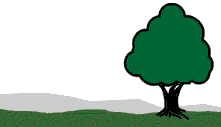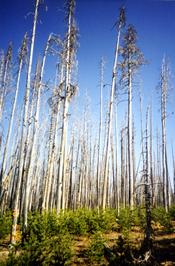
For more information on the effects of wildland fires and the adaptations of plants and animals, check out the following websites: Yellowstone and the Fires of Change: Ecological Factors
Wildland
Fires: Effects
Wildland
fires
are
natural events that have occurred periodically throughout history. There are three major classes of wildland fires: ground fires, surface
fires, and crown fires. Ground fires spread across the grass and low-lying
vegetation. Surface fires burn the trunks of trees as well as the grass
and low-lying vegetation. During crown fires, the flames move across the
ground, up the trees, and across the crowns (tops) of the trees. Crown
fires are the most dangerous and destructive class of wildland fire.
There are three major classes of wildland fires: ground fires, surface
fires, and crown fires. Ground fires spread across the grass and low-lying
vegetation. Surface fires burn the trunks of trees as well as the grass
and low-lying vegetation. During crown fires, the flames move across the
ground, up the trees, and across the crowns (tops) of the trees. Crown
fires are the most dangerous and destructive class of wildland fire.
Wildland fires appear to be very destructive to the wildland ecosystem. Wildland fires damage natural resources such as timber. They destroy livestock pastures and wildlife habitat, as well. In addition, the reduction in vegetation can lead to increased soil erosion because there are no longer living roots holding the soil in place. On top of all the negative impacts of wildland fires on the health of ecosystems, wildland fires also destroy the beauty of the environment. They are often viewed as scars on the landscape.
On the other hand, fire can change an ecosystem without necessarily destroying it. The damage from wildland fires may not always be as bad as it first seems. For instance, fires are spread in patches--leaving behind large, unburned areas. Therefore, the number of acres that actually burn may be far less than the number of acres a fire spreads across. In addition, fires do not destroy every living thing within the burned areas. Some trees can survive even when their crowns are scorched.
Wildland ecosystems do not just survive fires. Some of them are even made healthier. For example, small fires reduce the total amount of fuel (dry, dead vegetation) on forest floors. Large crown fires can burn in a patchwork pattern, thus creating areas with trees of different ages. This keeps the overall ecosystem more stable.
Surviving plants may also benefit from the fire's quick breakdown of nutrient-rich organic matter. The surge of nutrients may stimulate plant growth. Many animals seek out burned sites for the newly available minerals and for the fresh plant material.
 Some
trees and other plants and animals in wildlands that experience regular
fires have developed special traits and abilities that allow them to survive
in these habitats. Trees like the giant sequoia and the ponderosa pine
have developed thick bark that acts as insulation from the heat of wildland
fires. Thin-barked trees may use other survival techniques. They may produce
new growth from roots that were underground and insulated from the fire's
heat by the soil. Other plants insulate their buds. Animals may survive
by simply running out of the path of the fire. Or they may burrow underground
where it remains cool. Photo: New growth
emerging in Yellowstone. Photo courtesy of Gayle Croft.
Some
trees and other plants and animals in wildlands that experience regular
fires have developed special traits and abilities that allow them to survive
in these habitats. Trees like the giant sequoia and the ponderosa pine
have developed thick bark that acts as insulation from the heat of wildland
fires. Thin-barked trees may use other survival techniques. They may produce
new growth from roots that were underground and insulated from the fire's
heat by the soil. Other plants insulate their buds. Animals may survive
by simply running out of the path of the fire. Or they may burrow underground
where it remains cool. Photo: New growth
emerging in Yellowstone. Photo courtesy of Gayle Croft.
Many plants have evolved so that they not only survive the periodic fires, but they depend on them. For example, some plants can only grow when surrounding plants that block the sunlight or compete for nutrients in the soil are burned in fires. The seeds of some plants must be burned before they can germinate. The cones of the lodgepole pine tree must be exposed to a lot of heat before they can even release their seeds. This is because resin in the cones holds them closed. When the temperature gets high enough, the cones crack open and spread their seeds.
Causes
..|..
Effects
.
Glossary
|
Related Links
|
References
|
PBL Model
HTML code by Chris
Kreger
Maintained by ETE
Team
Last updated April 28, 2005
Some images © 2004 www.clipart.com
Privacy Statement and Copyright © 1997-2004 by Wheeling Jesuit University/NASA-supported Classroom of the Future. All rights reserved.
Center for Educational Technologies, Circuit Board/Apple graphic logo, and COTF Classroom of the Future logo are registered trademarks of Wheeling Jesuit University.
